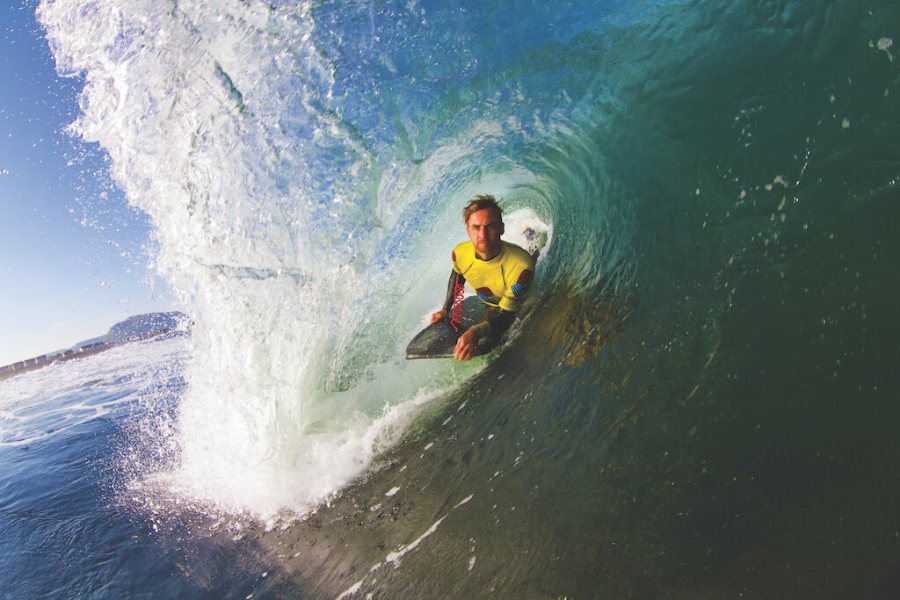Bodyboarding is often overlooked as a serious watersport, but there’s a whole lot more to it than messing around on holiday, as Becky Dickinson writes.
Think watersports and you probably think surfing, swimming, kitesurfing, wakeboarding, kayaking or even paddleboarding.
But bodyboarding…that’s just something screaming kids do on holiday.
Well, not quite. While bodyboarding, or boogie boarding as it’s sometimes known, is the cheapest and most accessible of all watersports – hence its popularity with children and holiday makers – there is much more to it than meets the shoreline.
If you want to up your game, you need to get out of your depth, but for beginners, bodyboarding provides almost instant rewards.
“It’s a sport that welcomes all levels of fitness,” says Rob Barber of bodyboard-holidays.com. “It’s an amazing way to have fun, keep fit and it holds no age boundaries.”
Barber, who was formerly the highest ranked rider in Europe, now devotes much of his time to coaching, both in the UK and abroad, and has taught a whole spectrum of abilities, from total novices to the British team.

Elite bodyboarding is no child’s play | Photography: Rob Barber
In at the deep end
Yet as inclusive as it is, bodyboarding isn’t all fun and frolics in the foam. At an elite level, it’s just as demanding and as competitive as surfing.
“The initial goals come much easier,” says Barber, “but at the top end of the sport, to ride the most challenging waves in the world and to demonstrate the most technical moves you require comparable skill and experience.”
If you’re a complete beginner, you can catch your first wave simply by wading out to where your feet can still touch, then launching your board towards the beach and jumping on top with an incoming wave.
However, to turn it from a bit of a laugh into an actual sport you need to paddle ‘out back’ into the zone more commonly populated by surfers.
To get there, you’ll need a pair of swim fins (or flippers) and a reasonable board (as opposed to the breakable and environmentally damaging imitations sold in supermarkets.)
You’ll also need to master the art of duck diving – the technique of diving below the surface of a crumbling wave in order to get further out to sea without being pummelled back to the beach.
While it helps to be a half-decent swimmer, it isn’t as imperative as you might think.
“Being able to swim is relevant in the early stages of your bodyboarding, as it greatly improves your confidence,” says Barber. “But that’s where the relevance ends, as paddling your bodyboard with your arms and your legs is a different technique to swimming strokes.”
Look after your lungs
If you really want to progress, then cardio fitness is crucial. “There is a lot of sprint paddling, duck diving, gymnastic moves, spells of being out of breath while managing wipe-outs and also heavy landings after the biggest moves,” adds Barber.
At this level, bodyboarding provides some huge physical gains, including increased core stability, agility, flexibility and controlled breathing.
When it comes to flexibility, many of the world’s best bodyboarders, including the three times World Champion, Jeff Hubbard, swear by yoga.
As well as reducing risk of injuries (which are rare in comparison to other water sports) being able to stretch and twist your body beyond the norm, is key if you want to pull off the most impressive aerial stunts.
Agility, strength and athleticism are all vital if you want to improve your performance, so any training routine needs to incorporate all these elements.
“Bodyboarding at the elite level is very tough on the body,” says professional British bodyboarder Matt Sharman.

Pro bodyboarder Matt Sharman | Photography: Adj Brown
Bodyweight basics
“To maintain strength and improve power, I do two to three bodyweight conditioning circuits per week, consisting of compound exercises and concentrating on working as many muscles together as possible.
“To maintain and improve flexibility, I also do a lot of stretching and some yoga. The latter assists with breathing techniques, which is useful for two wave hold downs (when you get held underwater for two waves in a row, without coming up for air).”
As well as working on his own skills and technique, former pro rugby player Sharman is on a mission to challenge the traditional image of bodyboarding as the softer, easier, relation of surfing.
RELATED: Toying With Nature: Inside The World Of Big-Wave Surfing
“This is simply not the case,” he insists. “Bodyboarding (at the professional level) is at the sharp end of hard-core surfing. We seek out waves that are considered unrideable by stand-up surfers – Nazaré in Portugal is a good example of a dangerous wave pioneered by bodyboarders.”
Head space
Bodyboarding is also good news for mental wellbeing. The combination of being immersed in natural beauty, plus the sheer adrenalin of riding waves, with your heart pressed to the ocean, is an incredible formula for happiness.
“You definitely achieve a zen state of mind as you take in the elements,” reflects Barber.
“The experience of being ‘out back’, in the area beyond the breaking waves, offers a peaceful serenity away from the pressures of land that is hard to replicate.
“By the same token, the experience of being so close to the face of the wave and the increased sense of speed is a real buzz. The bigger the wave, the bigger the thrill and it’s that which keeps you coming back for more.”








